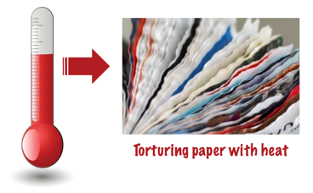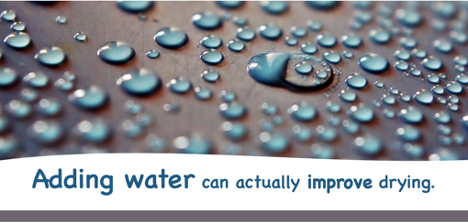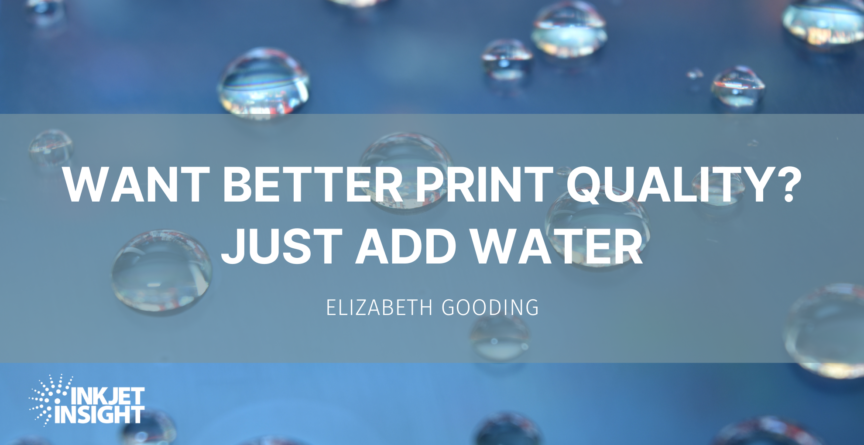Sponsored content
From the moment that a roll of paper enters your shop, it is at the mercy of moisture and heat. Just sitting in a warehouse waiting to be used, the failure to control the humidity and temperature of the paper can lead to problems with printing and finishing. This is because paper can change its shape when excess moisture expands the fibers, and even when moisture is removed. This can be seen as warping or waves at the edges of the roll or moisture welts if the roll packaging is damaged. Temperature can also impact performance, which is why it is recommended that paper be normalized to the temperature of the press room before use.
If print performance can be negatively impacted while sitting passively in the warehouse, imagine what can happen when it is exposed to the tortuous process of running through a continuous inkjet press.
Torturing paper with inkjet
Managing the print quality of a high-speed aqueous inkjet press is a complex balancing act of jetting ink on the page and then removing the water from the ink while leaving the colorant behind, all while the paper is held under tension on the moving web. While drying technology has advanced dramatically in recent years to allow for higher ink coverage, effectively separating the ink colorant from its aqueous carrier usually involves subjecting the ink to temperatures at or beyond the boiling point of water. The water in the ink boils away but so does the moisture in the paper. When paper becomes too dry it can become weak and brittle. In a two-tower system, after the paper is rolled and baked on one side it has to go through the process all over again.
 Paper is manufactured with different moisture levels to suit the intended end use. On average, the moisture content of paper before printing is between four and six percent. After running through drying systems such as hot air nozzles, air knives or heated rollers, the moisture content of the paper may drop to one percent. That is not enough moisture content to keep the paper flexible. When inadequate moisture remains after printing, brittle fibers can result in cracking or tearing during folding, binding and inserting. Even if the paper is able to survive the print and finishing process, it can still change shape due to the moisture imbalance between the paper and the surrounding environment. The paper will draw moisture from the air, before or after leaving your shop, in order to reach an equilibrium level of relative humidity.
Paper is manufactured with different moisture levels to suit the intended end use. On average, the moisture content of paper before printing is between four and six percent. After running through drying systems such as hot air nozzles, air knives or heated rollers, the moisture content of the paper may drop to one percent. That is not enough moisture content to keep the paper flexible. When inadequate moisture remains after printing, brittle fibers can result in cracking or tearing during folding, binding and inserting. Even if the paper is able to survive the print and finishing process, it can still change shape due to the moisture imbalance between the paper and the surrounding environment. The paper will draw moisture from the air, before or after leaving your shop, in order to reach an equilibrium level of relative humidity.
It may seem counterintuitive, but these problems can actually be addressed by adding more humidity to the environment at the same time that the press is trying to remove moisture from the ink. The problem is that, due to varying ink coverage and printing one side of the sheet at a time, part of the paper may not have any ink on it and coverage on the rest may vary. This means that the paper will absorb more or less water in different spots. If we add moisture to the production process without controls, we can get more extreme variations of the problems discussed in relation to improper paper storage, as moisture expands the paper fibers in an uneven manner. To control print quality, moisture must also be controlled.
Managing moisture to manage quality
Adding moisture back into the production process in a controlled manner is complex. At the environment level, the remoisturizing process must consider the target amount of moisture to add back into the system. For example, if the moisture content of the paper, without added humidity, was five percent before printing and one percent after printing the remoisturizing system needs to add four percent moisture back into the process. However, that is just one facet of the challenge. The system must adjust for the amount of moisture already in the environment and different evaporation levels on the first and second side of the sheet, as well as the overall porosity of the substrate.

Also consider that each page printed may be different and the level of coverage on each area of each side of the page may be different. Moisture settings need to be adjusted to compensate for these factors and to deliver the appropriate level of added moisture to the entire paper surface. The amount of precision that can be applied to delivering the right amount of moisture to the right place can make a tremendous difference in the uniformity of the printed output and its compatibility with finishing processes.
Some remoistening systems are able to control moisture at a specificity of milligrams per square meter, and adjust the level of added moisture for each side of the sheet. Employing a remoistening system that is easy to adjust is particularly valuable when many different types of papers are used because the optimal moisture settings will be different for each and every one.
Protecting from further humidification
Moisture can be added, or removed, from paper before, during or after production. When the change in moisture is not managed, the paper surface can become unstable. Paper can resemble a canoe when the edges curl up due to different levels of moisture on each side of the sheet. When more than the edges are effected, the paper can become wavy. Both of these issues result in finished work that doesn’t lay flat, looks imperfect and may not run through the full production process without problems. Both of these issues can be addressed with controlled addition of humidity using a precise remoistening system.
But once the print leaves the press, it is still subject to the whims of humidity. Having the paper exit the process with a near equilibrium moisture balance helps avoid post-process moisture absorption. Gaining more moisture is a particular problem for bound products like books and magazines that may use different substrates and processes for the cover and the body or signature. If the signature pages absorb moisture and expand, they can become thicker. However, moisture induced growth is not uniform. The paper will expand perpendicular to the direction of the fibers. If covers are printed on offset or toner presses, or are post coated, they may not absorb moisture at all. This leads to a problem of a bound product “outgrowing” its cover.
In addition to remoisturizing during the production process, adding a silicone coating provides additional protection from the high temperatures of drying as well as a layer of protection that lasts beyond the print process. A silicone coating protects the paper when running through the finishing process and also reduces absorption of moisture following production.
Control moisture from start to finish – and beyond
To create an environment for optimal inkjet printing on any compatible media:
- Store the media in a humidity and temperature controlled environment
- Acclimate the media to the conditions of the production environment in advance
- Use an easily controlled, precision remoistening system approved for your inkjet environment
- Add silicone coating for bound or inline finished materials, or any material subject to high variations in humidity
The Contiweb DFA is a digital fluid applicator that provides remoistening using plain tap water and a surfactant with the addition to add pure silicone oil for added protection. When using silicone, the oil is mixed with tap water just prior to application. The water is absorbed by the paper but the oil stays on top to protect the finished product. Using the Contiweb DFA, remoistening fluids are applied uniformly to the paper surface with the ability to create individual settings for each side of the web in milligrams per square meter. We recently covered the reseller agreement announced between Contiweb and Canon in an interview with Ed Jansen of Canon Solutions America and Rob Bosman of Contiweb. Jansen described the partnership with Contiweb as “critical” and the ability to control the remoistening on both sides of the sheet with the Contiweb DFA as unique. Under the agreement, Canon will be reselling the Contiweb DFA with the ProStream 1800. Contiweb’s remoistening system is also compatible with continuous inkjet presses from HP, Kodak, Screen and Ricoh. Don’t leave inkjet print quality to the mercy of moisture and heat. Take control with a digital remoistening system.
Sponsored content

